Mitigating DDoS Attacks in SDN-Based IoT Networks Leveraging Secure Control and Data Plane Algorithm
Abstract
1. Introduction
Research Contributions
- We also deeply analyse the state-of-the-art DDoS attacks in the SDN and SDN-based IoT networks.
- We replicate IoT realistic traffic models and DDoS attacks by emulations and physical SDN-based IoT hardware and software equipment. From the real implementation, we have authentic results to evaluate the impact and outcome of DDoS attacks in the IoT networks.
- We also report observations on the effect of DDoS attacks with periodical and event trigger IoT traffic in the SDN architecture.
2. Related Work
2.1. DDoS Attacks on SDN
2.2. Security in SDN-Based IoT Networks
3. IoT Traffic Models
- Periodical: This is a typical IoT traffic model applied to passive monitoring applications. A monitor generates stable traffic every predetermined period to update the state of object. This kind of traffic is always predictable between an IoT end-user device and an IoT data platform collector (IoT-DPC). For example, smart city applications, IoT in agriculture, smart grids, healthcare and farming devices send periodic messages along with statistics to the IoT-DPC for monitoring.
- Event Trigger: This is a typical IoT traffic model applied to dynamic monitoring applications. Event trigger happens occasionally to declare that an operation may be required. Although these events add uncertainty to the traffic flow, it is still under control due to its probability of presence. Devices in smart homes, wearables, connected car, industrial IoT and smart retail might randomly generate information to the IoT-DPC. These events only arise in a low frequency; otherwise, real-time monitoring might not be necessary.
- Smart Home (event trigger) includes diverse real-time monitor and event triggered actions. Typical scenarios include home condition retrieve, preconfigured intelligent services and remote control of home appliances, achievable through sensors and Internet-connected devices at home [37]. For people who would like to manage from outside home, collected data are sent to the distant application IoT-DPC via a home gateway, such as a modem, and then the IoT-DPC tries to reach the user via mobile or wireless networks.
- Wearables (event trigger) are portable devices that have the capability to save and transmit data. Similar to mobile phones, these wearables may upload or download files and communicate over the Internet. As they are always carried by users and activated erratically, it is an arduous task to predict the access point and traffic utilisation.
- Connected Car (event trigger) is capable of communicating with other internal and external IoT devices, as well as accessing the Internet. Sensors embedded in the vehicle ensure the performance of driving, while modules exchanging data with peer vehicles avert the chance of a crash. As a connected car is able to gather information from devices nearby, it acts as a mobile collector in the IoT [38].
- Industrial IoT (event trigger) is a future project that pushes remarkable changes in both application and technology in the manufacturing system, the objective is to achieve service-oriented industry [39]. The key point is that users hand over their behaviour and feedback to the factory in real time, and the factory reacts to these statistics by reconfiguring manufacturing process and regulating orders from suppliers [40]. As there are too many possibilities and combinations of customer feedback in this area, IoT traffic is unpredictable in these applications unless manufacturers predefine a duration for the comments.
- Smart City (periodical/event trigger) employs sensors all over the city to monitor the real-time state from environment to parking space. The architecture consists of three tiers: IoT sensor, IoT gateway and server. In the IoT sensor tier, devices are deployed in the facilities for dedicated tasks, which means the traffic is stable for a kind of service under a given gateway [41].
- IoT in Agriculture (periodical/event trigger) manages to read the status of farmland, such as soil moisture and temperature, to optimise the growing conditions without manual intervention [42]. As this kind of application has no requirement to share information with peers from time to time, traffic generated online is hard to foresee.
- Smart Retail (event trigger) saves customer interest and shopping history in the database. Once a customer walks into the store, a scan of member card causes the end device on the trolley to download personal details from the server. Traffic between the gateway in the branch and server reflects customer flows, which could be studied from statistics in the past.
- Smart Grid (periodical/event trigger) collects the usage information during the day so as to formulate a dynamic strategy for power supply. Various sensors on the transmission line monitor the change of environment and impact on the power line, they can access to the public network via mobile or optical networks [43]. As the number of sensors is solid in a region and the coverage of the server is constant, traffic flow received on the server is normally steady.
- Healthcare (periodical/event trigger) via IoT is achieved by sensors attached to the user to monitor real-time body functions. The results are sent to the server through a mobile network or broadband [44]. As these devices may connect to the server via different access points, traffic is unpredictable in this case.
- IoT in Farming (periodical/event trigger) fetches data from sensors and cameras in the poultry house to maintain a comfortable environment. A notification is sent to the farmer via the smartphone, and the operation is triggered due to exceeding certain thresholds [45]. Data collection is similar to IoT in agriculture, it can be accomplished without Internet access. Traffic is predictable due to the limited number of sensors and switches.
4. Characterising SDN-Based IoT Architecture
4.1. The Architecture of SDN Based IoT Networks
- IoT Data Aggregators (IoT-DAG): There are various IoT subscribers including attackers. A client collects data from IoT devices (wired or wireless sensors). These data could be originating from different applications. The client behaves as an upper level node accessing the SDN switches. In this article, we use Raspberry Pi (RPi) as the IoT-DAG, which is a mini-computer running an operating system similar to Linux. Although portable in terms of size, RPi is capable of processing data having graphical interface and could connect to the Internet via Ethernet cable or WiFi. Therefore, users can reprogram or configure it remotely, which is crucial to the IoT applications [49]. Another one is Odroid that supports Ubuntu and Android system with a more powerful RAM compared to other devices with the same size, it is even equipped with a heat sink [50]. These devices have some common points that meet IoT requirements: cheap, small size, easy-to-use, low energy consumption, open-source and adequate processing ability.
- SDN Switches: The support from a controller to the SDN switch is essential, although the switch can still work with its last configuration. As a legacy switch without a controller, SDN loses its power. Thus, the controller acts as a coordinator to instruct a switch and redirect different kinds of data to the destination via SDN. Zodiac-FX is the one we use in the test. It is a small OpenFlow switch that is designed to be used in the laboratory providing real traffic on the physical hardware. It has open-source firmware, simple setup procedure and CLI access. Zodiac-FX supports OpenFlow 1.0 and 1.3 and can obtain flow entries from controllers, such as Ryu [51]. This is a suitable choice to emulate SDN-based IoT networks to meet the aforementioned IoT requirements.
- IoT Data Servers (IoT-DS): Each IoT application has an independent server, which only processes its type of service. Both scheduled and random access share the same server. Google smart home is a typical random access service, it stores devices per room first and uses this information to create a database, called Home Graph (HG) [52]. Then, the Google Assistant (GA) on the server side will process the user’s request according to the HG. Google Home collects command from the user and sends it to the GA. The GA then tries to recognise the request and find relevant devices in the HG. Finally, the GA executes the operation via Google Home. Another instance is Amazon Website Service (AWS) IoT; with the aid of a cloud network, it simplifies the connection and management of enormous amount of IoT devices supporting data collection and complex analytics for reacting to the real-time actions [53].
- Reactive: Initially, there is no flow entry provisioned in the switch, except a default entry whose operation is to inquire the controller. Therefore, flow entries are generated according to the algorithm in the controller. It is fully flexible, yet the control plane is vulnerable in this scenario. As a mismatched customer packet can trigger a request to the controller, DDoS attacks could impact both the control and data plane.
- Proactive: Flow entries are preconfigured in the switch, the role of controller varies according to the default operation given by the administrator.
- −
- Drop when mismatch: No new flow entry is generated by the controller. Customer packets either follow the existing flow entries or be dropped. This kind of configuration sacrifices flexibility to higher security. As a host, the device is no longer capable of initialising a request to the controller. DDoS attacks from hosts can only take effect in the data plane.
- −
- Ask controller when mismatch: This is similar to reactive flow entries. However, DDoS attacks triggering on the controller could be more sensitive due to the preconfigured flow entries. Because most of the popular routes must have been covered by the proactive flow entries, there should not be many requests to the controller within a short period.
- Each end-user device behaves as an IoT-gateway or IoT-DAG that aggregates data from IoT-sensors (wired or wireless) and sends the IoT traffic to related IoT-DS or IoT-DPC.
- The IoT attacker could be a compromised gateway or IoT sensor, which creates malicious traffic in the network. The traffic could be divided into two categories depending on the destination IP address: (i) varied IP address (targeted to the controller) and (ii) fixed IP address (targeted to the server).
- The IoT-DS is an IoT server processing both TCP and UDP traffic sent by IoT-gateways. The IoT-Servers can be any computing platform providing services for IoT data collection or management.
4.2. The Proposed Algorithm for Mitigating DDoS
- Monitor Function: SECOD counts the number of messages generated from port in switch, as well as per IP address . Then, it sums up the total number of messages per switch , and compares with . Once exceeds , it means the controller is overloaded and the algorithm enters DDoS Detection module. Apart from , if one or multiple are greater than and is still under , then the algorithm enters Threshold Update and only updates the . Thus, each port of switch has a different threshold due to its past workload after the network running for some time.
- Threshold Update Function: This function is mainly used to update . During network initialisation, is used as a reference for DDoS detection, and later this threshold is updated to which reflects the network operation. keeps updating according to history statistics when the network is in normal state. If the network is just recovered from DDoS attack, is reset to , as the statistics during DDoS attacks cannot reveal the normal behaviour of network.
- DDoS Detection: This is the attack localisation phase before entering mitigation phase. The controller first sends a flow entry to all the suspicious switches, and this flow entry asks the switch to drop all the new flows that cannot match the existing flow table within a extremely short period. If the controller receives no messages during that period, then the attack is originated from hosts; otherwise, the switch is compromised. Depending on the result, it goes to Host/Switch Mitigation.
- Host Mitigation: SECOD checks and compares with . If there is only one abnormal , the controller inserts a flow entry to switch j so as to block packets from the suspicious IP address. If there are multiple anomalous , the controller asks the switch to drop all the packets from that port. The flow entry to block packets has idle timeout enabled, so that it is removed as soon as the attack stops.
- Switch Mitigation: As the switch is compromised, the controller is unable to manage that switch. Thus, SECOD instructs the controller not to process the messages from that malicious switch, but to keep counting the number of requests from that switch. When its is lower than , we regard it as DDoS attack is over, and then the flow entry which blocks the switch is removed.
4.3. Explanation of Key Operations in SECOD
4.3.1. Blocking Ports
4.3.2. Keep Counting
4.3.3. Controlling Packet_In
5. DDoS Attacks Emulation on SDN-Based IoT Architecture
5.1. Effect of SECOD in the Simulation
5.2. SDN-Based IoT Testbed
- In scenario-1, IoT-DAG-1 generates periodical and random TCP or UDP traffic one after another to verify the nature of each traffic type in the network.
- In scenario-2, IoT-DAG-1 generates periodical UDP and periodical TCP traffic, and IoT-DAG-2 generates random UDP and random TCP traffic.
5.3. IoT Traffic Emulation
- Periodical UDP Traffic: IoT-DAG transmits 100 bytes UDP packets every 10 s ( = 10 s). It is usually employed in smart city applications to collect information from sensors every period.
- Periodical TCP Traffic: IoT-DAG transmits TCP traffic with maximum available bandwidth every 60 s ( = 60 s). It is usually employed in the smart grid to read meters remotely every period.
- Random UDP Traffic: IoT-DAG transmits 100 UDP bytes every 60–120 s ( = 60 s, = 120 s). It usually happens on the wireless sensor devices when an event is triggered.
- Random TCP Traffic: IoT-DAG transmits TCP traffic with maximum available bandwidth every 60–120 s ( = 60 s, = 120 s). This usually happens on the personal device trying to connect to IoT applications, such as remote control of smart home.
5.4. Flow Operation Setup
5.5. SECOD Operations
- In order to stop the malicious packets, SECOD blocks suspicious requests at the first node, which is the ingress port of SDN. A filter based on the IP address tries to find the source of attack and drop its packets once received on the ingress SDN switch. The reason that we choose IP address instead of MAC address as the metric is because the MAC address of a packet will always be the MAC address of the port that is directly connected to the SDN switch. However, the IP address could be the original address of the sender (or address of a network address translation router), so filtering by IP will allow a lower rate of false positives. Note that if the attacker is able to modify source IP address, then SECOD will have to block the whole port of SDN switch, because if these malicious packets already impact on the normal users attached to the same SDN switch port, it can hardly figure out where is the source of attack if the hacker is sophisticated.
- For IoT traffic, the time period of periodical traffic is normally predefined, such as smart grids. Even for random traffic, the behaviour is predictable within an acceptable range, such as healthcare, it would not be infinite demand as in the traditional network. Random traffic that triggered by the event could be burst requests due to emergency situation, but they shall still under control because of the limit of original application. This feature makes SDN-based IoT network more efficient in detecting DDoS attacks, because the threshold of detection can be set more precisely according to different applications. Moreover, IoT applications can easily reach the user to inform any event or change. This helps the server to send out an alert to the abnormal device to ask for the involvement of user to check if the device is still working properly. Otherwise, it is separated from the network as a result of infection.
6. Results and Discussions
6.1. Network Performance Behaviour in Normal Operations
6.2. Network Performance Behaviour under DDoS Attacks
6.3. Network Performance Behaviour under DDoS Attacks with Different Idle_timeout
6.4. Network Performance Behaviour under DDoS Attacks Using a Powerful Controller
6.5. Network Performance Behaviour under DDoS Attacks with SECOD Activated
Improvements of SECOD for SDN-Based IoT Networks
7. Conclusions
- Random traffic (UDP or TCP) is more affected during DDoS attacks. Therefore, we can conclude that IoT event-trigger applications are more vulnerable to attacks than periodical ones.
- Metrics of OpenFlow and TCP connections can play an essential part in keeping at least a minimum performance under a DDoS attack. Therefore, this metric can be tuned based on the characteristics of IoT traffic that the network is supplying.
- Resources of control plane (controllers) play a minor role during DDoS attacks, if the data plane (switches) resources are already compromised.
- The SECOD algorithm is able to block DDoS attacks in the SDN-based IoT network, where traffic behaves like normal circumstances even under DDoS attacks; however, the performance in protecting random UDP traffic still requires improvements.
Author Contributions
Funding
Institutional Review Board Statement
Informed Consent Statement
Data Availability Statement
Acknowledgments
Conflicts of Interest
Abbreviations
| SDN | Software-Defined Networking |
| IoT | Internet of Things |
| DDoS | Distributed Denial of Service |
| RPi | Raspberry Pi |
| IoT-DAG | IoT Data Aggregator |
| IoT-DS | IoT Data Server |
| IoT-DPC | IoT Data Platform Collector |
| ARP | Address Resolution Protocol |
| P-CON | Powerful Controller |
| R-PI CON | Raspberry Pi Controller |
| ROC | Receiver Operating Characteristic |
References
- Open Networking Foundation. OpenFlow Switch Specification; ONF TS-024, v.1.4.1; Open Networking Foundation: Menlo Park, CA, USA, 2015. [Google Scholar]
- Dargahi, T.; Caponi, A.; Ambrosin, M.; Bianchi, G.; Conti, M. A Survey on the Security of Stateful SDN Data Planes. IEEE Commun. Surv. Tutor. 2017, 19, 1701–1725. [Google Scholar] [CrossRef]
- Lenka, R.K.; Rath, A.K.; Tan, Z.; Sharma, S.; Puthal, D.; Simha, N.V.R.; Prasad, M.; Raja, R.; Tripathi, S.S. Building Scalable Cyber-Physical-Social Networking Infrastructure Using IoT and Low Power Sensors. IEEE Access 2018, 6, 30162–30173. [Google Scholar] [CrossRef]
- Akpakwu, G.A.; Silva, B.J.; Hancke, G.P.; Abu-Mahfouz, A.M. A Survey on 5G Networks for the Internet of Things: Communication Technologies and Challenges. IEEE Access 2018, 6, 3619–3647. [Google Scholar] [CrossRef]
- Galeano-Brajones, J.; Carmona-Murillo, J.; Valenzuela-Valdés, J.F.; Luna-Valero, F. Detection and Mitigation of DoS and DDoS Attacks in IoT-Based Stateful SDN: An Experimental Approach. Sensors 2020, 20, 816. [Google Scholar] [CrossRef] [PubMed]
- Singh, J.; Behal, S. Detection and mitigation of DDoS attacks in SDN: A comprehensive review, research challenges and future directions. Comput. Sci. Rev. 2020, 37, 100279. [Google Scholar] [CrossRef]
- Valdivieso Caraguay, Á.L.; Benito Peral, A.; Barona López, L.I.; García Villalba, L.J. SDN: Evolution and opportunities in the development IoT applications. J. Distrib. Sens. Netw. 2014, 10, 735142. [Google Scholar] [CrossRef]
- Wang, S.; Gomez, K.; Kandeepan, S. SECO: SDN sEcure COntroller Algorithm for Detecting and Defending Denial-of-Service Attacks. In Proceedings of the 2017 5th International Conference on Information and Communication Technology (ICoIC7), Melaka, Malaysia, 17–19 May 2017. [Google Scholar]
- Wang, S.; Chandrasekharan, S.; Gomez, K.; Kandeepan, S.; Al-Hourani, A.; Asghar, M.R.; Russello, G.; Zanna, P. SECOD: SDN sEcure control and data plane algorithm for detecting and defending against DoS attacks. In Proceedings of the NOMS 2018—2018 IEEE/IFIP Network Operations and Management Symposium, Taipei, Taiwan, 23–27 April 2018; pp. 1–5. [Google Scholar]
- Sahay, R.; Meng, W.; Jensen, C.D. The application of Software Defined Networking on securing computer networks: A survey. J. Netw. Comput. Appl. 2019, 131, 89–108. [Google Scholar] [CrossRef]
- Dayal, N.; Srivastava, S. Analyzing behavior of DDoS attacks to identify DDoS detection features in SDN. In Proceedings of the 2017 9th International Conference on Communication Systems and Networks (COMSNETS), Bengaluru, India, 4–8 January 2017; pp. 274–281. [Google Scholar] [CrossRef]
- Dao, N.N.; Park, J.; Park, M.; Cho, S. A feasible method to combat against DDoS attack in SDN network. In Proceedings of the 2015 International Conference on Information Networking (ICOIN), Siem Reap, Cambodia, 12–14 January 2015; pp. 309–311. [Google Scholar] [CrossRef]
- Mousavi, S.M.; St-Hilaire, M. Early detection of DDoS attacks against SDN controllers. In Proceedings of the 2015 International Conference on Computing, Networking and Communications (ICNC), Anaheim, CA, USA, 16–19 February 2015; pp. 77–81. [Google Scholar] [CrossRef]
- Dong, P.; Du, X.; Zhang, H.; Xu, T. A detection method for a novel DDoS attack against SDN controllers by vast new low-traffic flows. In Proceedings of the 2016 IEEE International Conference on Communications (ICC), Kuala Lumpur, Malaysia, 23–27 May 2016; pp. 1–6. [Google Scholar] [CrossRef]
- Yan, Q.; Gong, Q.; Yu, F.R. Effective software-defined networking controller scheduling method to mitigate DDoS attacks. Electron. Lett. 2017, 53, 469–471. [Google Scholar] [CrossRef]
- Dharma, N.I.G.; Muthohar, M.F.; Prayuda, J.D.A.; Priagung, K.; Choi, D. Time-based DDoS detection and mitigation for SDN controller. In Proceedings of the 2015 17th Asia-Pacific Network Operations and Management Symposium (APNOMS), Busan, Korea, 19–21 August 2015; pp. 550–553. [Google Scholar] [CrossRef]
- Shoeb, A.; Chithralekha, T. Resource management of switches and Controller during saturation time to avoid DDoS in SDN. In Proceedings of the 2016 IEEE International Conference on Engineering and Technology (ICETECH), Coimbatore, India, 17–18 March 2016; pp. 152–157. [Google Scholar] [CrossRef]
- Xiao, P.; Li, Z.; Qi, H.; Qu, W.; Yu, H. An Efficient DDoS Detection with Bloom Filter in SDN. In Proceedings of the 2016 IEEE Trustcom/BigDataSE/ISPA, Tianjin, China, 23–26 August 2016; pp. 1–6. [Google Scholar] [CrossRef]
- RT, K.; Selvi, S.T.; Govindarajan, K. DDoS detection and analysis in SDN-based environment using support vector machine classifier. In Proceedings of the 2014 Sixth International Conference on Advanced Computing (ICoAC), Chennai, India, 17–19 December 2014; pp. 205–210. [Google Scholar]
- Phan, T.V.; Bao, N.K.; Park, M. A Novel Hybrid Flow-Based Handler with DDoS Attacks in Software-Defined Networking. In Proceedings of the IEEE Conferences on UIC/ATC/ScalCom/CBDCom/IoP/SmartWorld, Toulouse, France, 18–21 July 2016; pp. 350–357. [Google Scholar]
- Lim, S.; Ha, J.; Kim, H.; Kim, Y.; Yang, S. A SDN-oriented DDoS blocking scheme for botnet-based attacks. In Proceedings of the Conference on Ubiquitous and Future Networks, Shanghai, China, 8–11 July 2014; pp. 63–68. [Google Scholar] [CrossRef]
- Chin, T.; Mountrouidou, X.; Li, X.; Xiong, K. An SDN-supported collaborative approach for DDoS flooding detection and containment. In Proceedings of the IEEE Military Communications Conference, Tampa, FL, USA, 26–28 October 2015; pp. 659–664. [Google Scholar] [CrossRef]
- Macedo, R.; de Castro, R.; Santos, A.; Ghamri-Doudane, Y.; Nogueira, M. Self-Organized SDN Controller Cluster Conformations against DDoS Attacks Effects. In Proceedings of the IEEE Global Communications Conference, Washington, DC, USA, 4–8 December 2016; pp. 1–6. [Google Scholar] [CrossRef]
- Hameed, S.; Khan, H.A. Leveraging SDN for collaborative DDoS mitigation. In Proceedings of the 2017 International Conference on Networked Systems, Gottingen, Germany, 13–16 March 2017; pp. 1–6. [Google Scholar] [CrossRef]
- Sahay, R.; Blanc, G.; Zhang, Z.; Debar, H. ArOMA: An SDN based autonomic DDoS mitigation framework. Comput. Secur. 2017, 70, 482–499. [Google Scholar] [CrossRef]
- Tortonesi, M.; Michaelis, J.; Morelli, A.; Suri, N.; Baker, M.A. SPF: An SDN-based middleware solution to mitigate the IoT information explosion. In Proceedings of the IEEE Symposium on Computers and Communication, Messina, Italy, 27–30 June 2016; pp. 435–442. [Google Scholar] [CrossRef]
- Özçelik, M.; Chalabianloo, N.; Gür, G. Software-defined edge defense against IoT-based DDoS. In Proceedings of the 2017 IEEE International Conference on Computer and Information Technology (CIT), Helsinki, Finland, 21–23 August 2017; pp. 308–313. [Google Scholar]
- Sarwar, M.A.; Hussain, M.; Anwar, M.U.; Ahmad, M. FlowJustifier: An optimized trust-based request prioritization approach for mitigation of SDN controller DDoS attacks in the IoT paradigm. In Proceedings of the 3rd International Conference on Future Networks and Distributed Systems, Paris, France, 1–2 July 2019; pp. 1–9. [Google Scholar]
- Ravi, N.; Shalinie, S.M. Learning-driven detection and mitigation of DDoS attack in IoT via SDN-cloud architecture. IEEE Internet Things J. 2020, 7, 3559–3570. [Google Scholar] [CrossRef]
- Sharma, P.K.; Singh, S.; Park, J.H. OpCloudSec: Open cloud software defined wireless network security for the Internet of Things. Comput. Commun. 2018, 122, 1–8. [Google Scholar] [CrossRef]
- Nobakht, M.; Sivaraman, V.; Boreli, R. A host-based intrusion detection and mitigation framework for smart home IoT using OpenFlow. In Proceedings of the 2016 11th International Conference on Availability, Reliability and Security (ARES), Salzburg, Austria, 31 August–2 September 2016; pp. 147–156. [Google Scholar]
- Laboratory, M. Intrusion Detection Attacks Database. Available online: https://archive.ll.mit.edu/ideval/data/index.html (accessed on 6 October 2020).
- Al Shuhaimi, F.; Jose, M.; Singh, A.V. Software defined network as solution to overcome security challenges in IoT. In Proceedings of the IEEE Conference on Reliability, Infocom Technologies and Optimization (Trends and Future Directions), Noida, India, 7–9 September 2016; pp. 491–496. [Google Scholar]
- Ahmed, M.E.; Kim, H. DDoS Attack Mitigation in Internet of Things Using Software Defined Networking. In Proceedings of the IEEE Conference on Big Data Computing Service and Applications, San Francisco, CA, USA, 6–9 April 2017; pp. 271–276. [Google Scholar] [CrossRef]
- Lee, I.; Lee, K. The Internet of Things (IoT): Applications, investments, and challenges for enterprises. Bus. Horiz. 2015, 58, 431–440. [Google Scholar] [CrossRef]
- Sivanathan, A.; Sherratt, D.; Gharakheili, H.H.; Radford, A.; Wijenayake, C.; Vishwanath, A.; Sivaraman, V. Characterizing and classifying IoT traffic in smart cities and campuses. In Proceedings of the 2017 IEEE Conference on Computer Communications Workshops (INFOCOM WKSHPS), Atlanta, GA, USA, 1–4 May 2017; pp. 559–564. [Google Scholar]
- Chong, G.; Zhihao, L.; Yifeng, Y. The research and implement of smart home system based on Internet of Things. In Proceedings of the Conference on Electronics, Communications and Control, Ningbo, China, 9–11 September 2011; pp. 2944–2947. [Google Scholar] [CrossRef]
- Coppola, R.; Morisio, M. Connected car: Technologies, issues, future trends. ACM Comput. Surv. 2016, 49, 46. [Google Scholar] [CrossRef]
- Lasi, H.; Fettke, P.; Kemper, H.G.; Feld, T.; Hoffmann, M. Industry 4.0. Bus. Inf. Syst. Eng. 2014, 6, 239–242. [Google Scholar] [CrossRef]
- Shrouf, F.; Ordieres, J.; Miragliotta, G. Smart factories in Industry 4.0: A review of the concept and of energy management approached in production based on the Internet of Things paradigm. In Proceedings of the IEEE Conference on Industrial Engineering and Engineering Management, Selangor Darul Ehsan, Malaysia, 9–12 December 2014; pp. 697–701. [Google Scholar] [CrossRef]
- Theodoridis, E.; Mylonas, G.; Chatzigiannakis, I. Developing an IoT Smart City Framework. In IISA 2013; IEEE: Piraeus, Greece, 2013; pp. 1–6. [Google Scholar] [CrossRef]
- Mohanraj, I.; Ashokumar, K.; Naren, J. Field Monitoring and Automation Using IoT in Agriculture Domain. Procedia Comput. Sci. 2016, 93, 931–939. [Google Scholar] [CrossRef]
- Ou, Q.; Zhen, Y.; Li, X.; Zhang, Y.; Zeng, L. Application of Internet of Things in Smart Grid Power Transmission. In Proceedings of the Conference on Mobile, Ubiquitous, and Intelligent Computing, Vancouver, BC, Canada, 26–28 June 2012; pp. 96–100. [Google Scholar] [CrossRef]
- Gope, P.; Hwang, T. BSN-Care: A secure IoT-based modern healthcare system using body sensor network. IEEE Sens. J. 2016, 16, 1368–1376. [Google Scholar] [CrossRef]
- Mahale, R.B.; Sonavane, S. Smart Poultry Farm Monitoring Using IoT and Wireless Sensor Networks. J. Adv. Res. Comput. Sci. 2016, 7. [Google Scholar] [CrossRef]
- Ordonez-Lucena, J.; Ameigeiras, P.; Lopez, D.; Ramos-Munoz, J.J.; Lorca, J.; Folgueira, J. Network Slicing for 5G with SDN/NFV: Concepts, Architectures, and Challenges. IEEE Commun. Mag. 2017, 55, 80–87. [Google Scholar] [CrossRef]
- Wang, S.; Wu, X.; Chen, H.; Wang, Y.; Li, D. An optimal slicing strategy for SDN based smart home network. In Proceedings of the 2014 International Conference on Smart Computing, Hong Kong, China, 3–5 November 2014. [Google Scholar]
- Xu, X.; Zhang, H.; Dai, X.; Hou, Y.; Tao, X.; Zhang, P. SDN based next generation Mobile Network with Service Slicing and trials. China Commun. 2014, 11, 65–77. [Google Scholar] [CrossRef]
- Raspberry Pi Foundation. 2020. Available online: https://www.raspberrypi.org/ (accessed on 6 March 2020).
- Hardkernel Co., Ltd. Odriod. 2020. Available online: http://www.hardkernel.com/ (accessed on 7 March 2020).
- Northbound Networks Pty. Ltd. Zodiac. 2019. Available online: http://northboundnetworks.com/collections/zodiac-fx/products/zodiac-fx (accessed on 20 December 2019).
- Google. 2020. Available online: https://developers.google.com/actions/smarthome (accessed on 12 March 2020).
- Amazon. 2020. Available online: https://aws.amazon.com/iot (accessed on 12 March 2020).
- Benvenuti, C. Understanding Linux Network Internals; O’Reilly Media, Inc.: Sebastopol, CA, USA, 2006. [Google Scholar]
- Wani, A.; Revathi, S. DDoS Detection and Alleviation in IoT using SDN (SDIoT-DDoS-DA). JIEIB 2020, 101, 117–128. [Google Scholar] [CrossRef]
- Yu, Y.; Guo, L.; Liu, Y.; Zheng, J.; Zong, Y. An efficient SDN-based DDoS attack detection and rapid response platform in vehicular networks. IEEE Access 2018, 6, 44570–44579. [Google Scholar] [CrossRef]
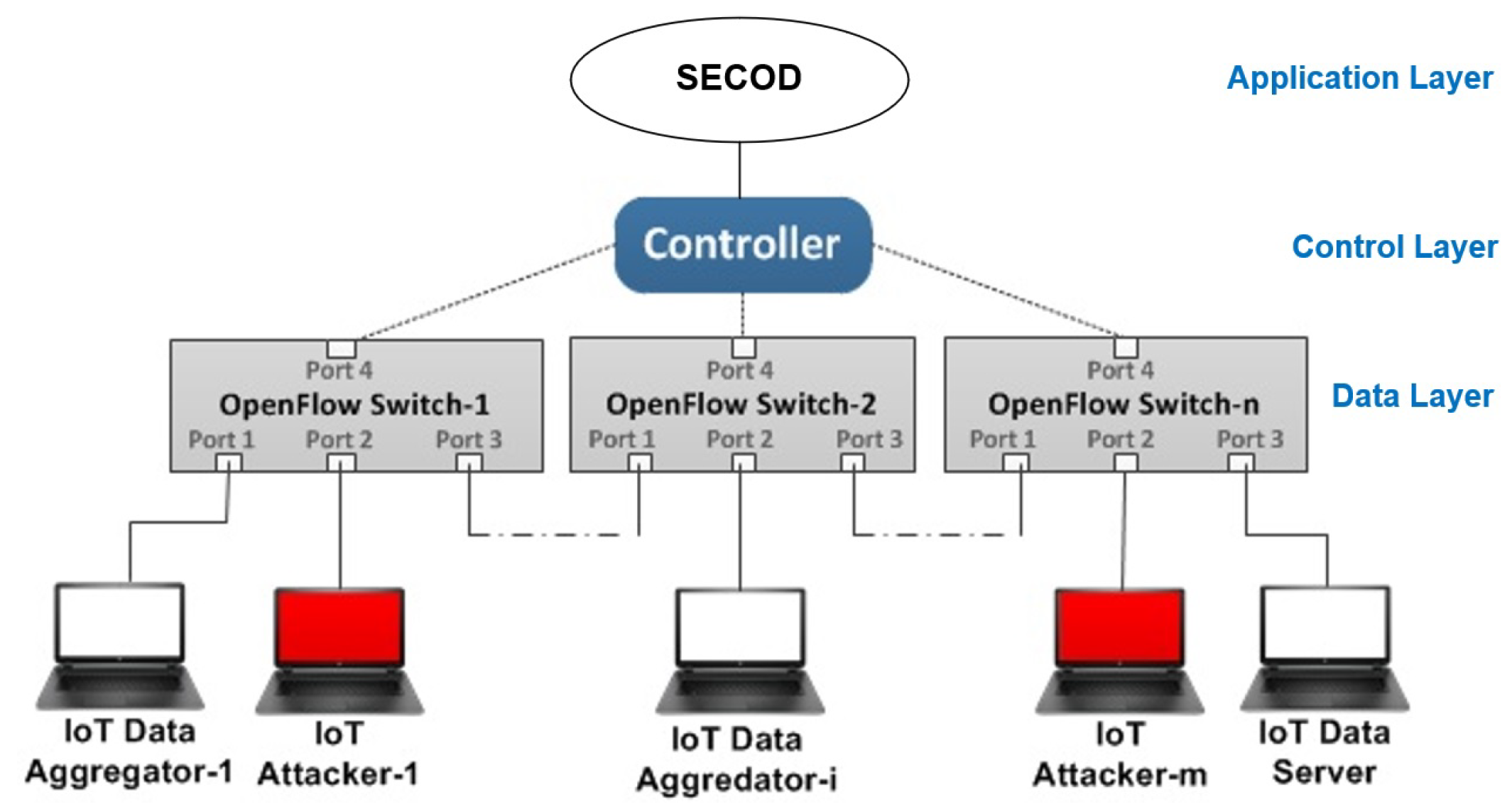
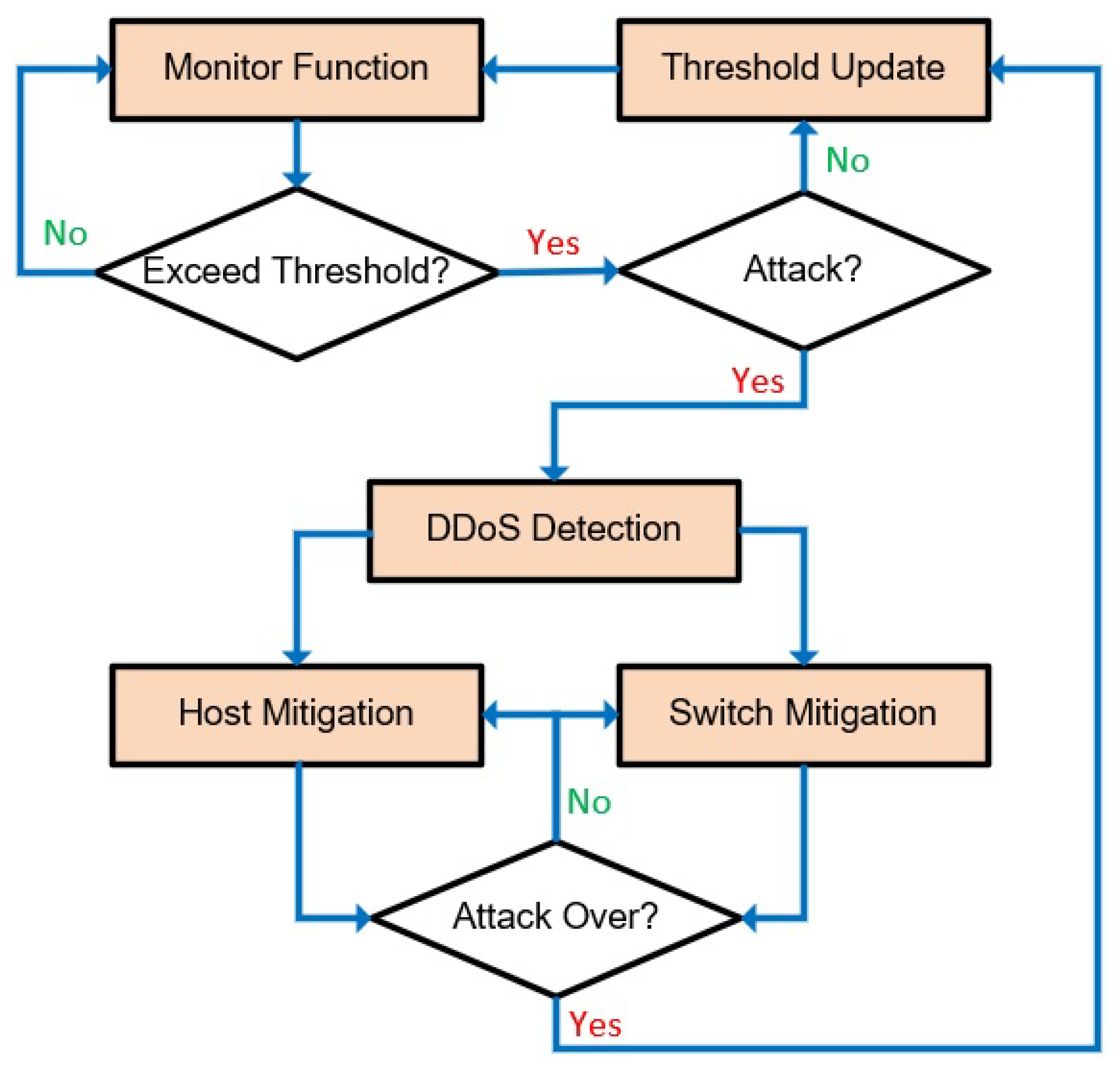



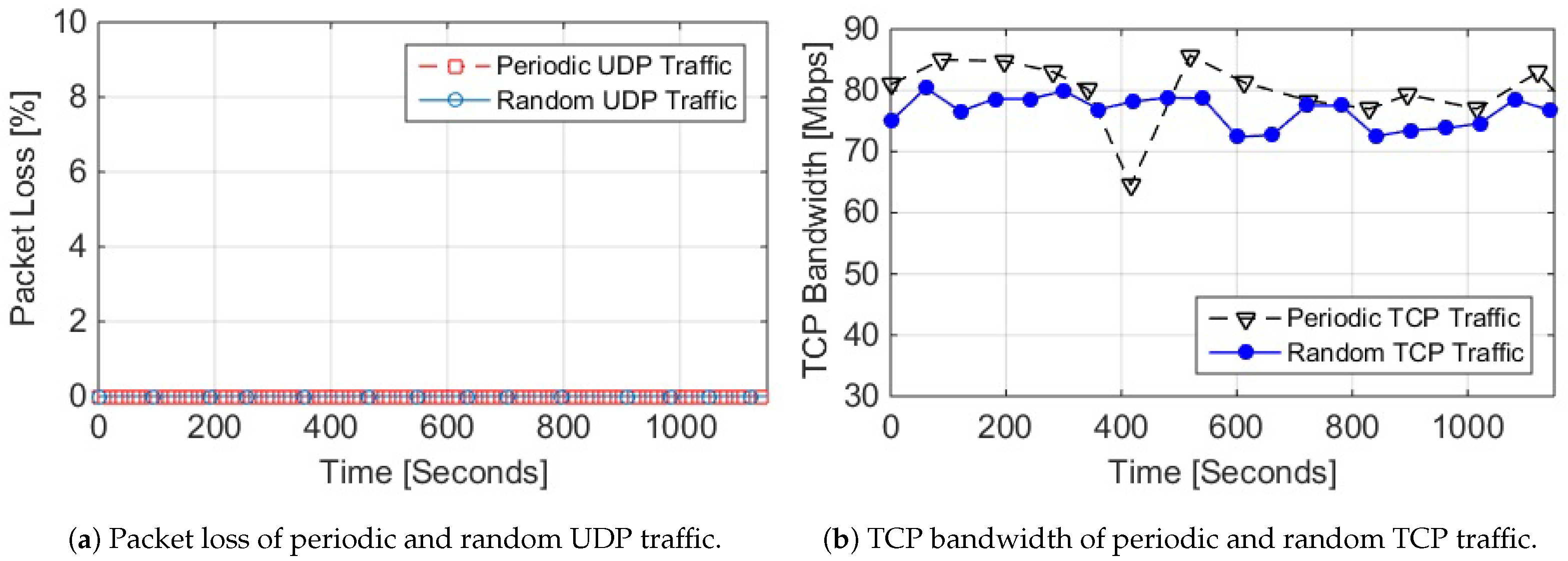
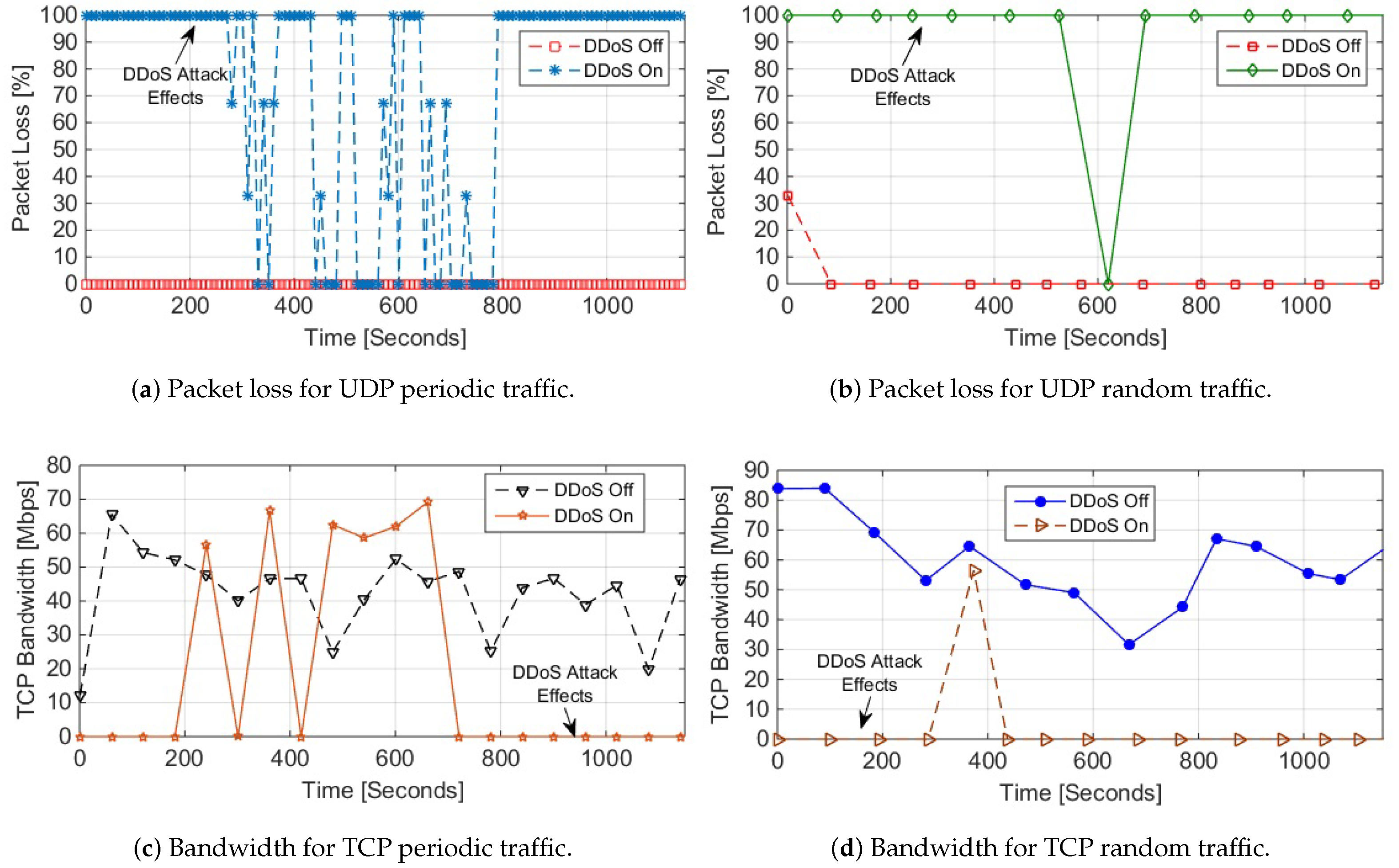
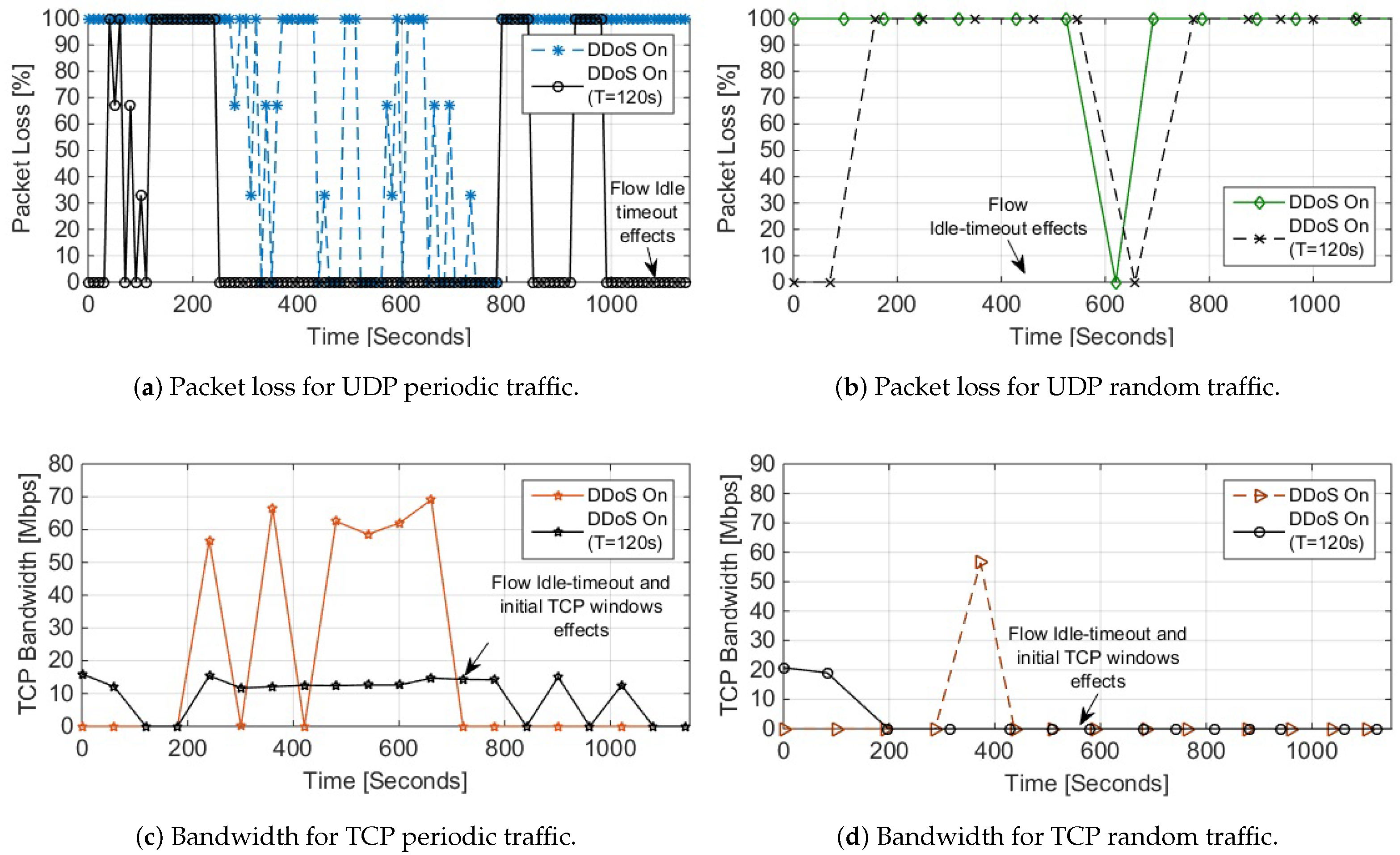
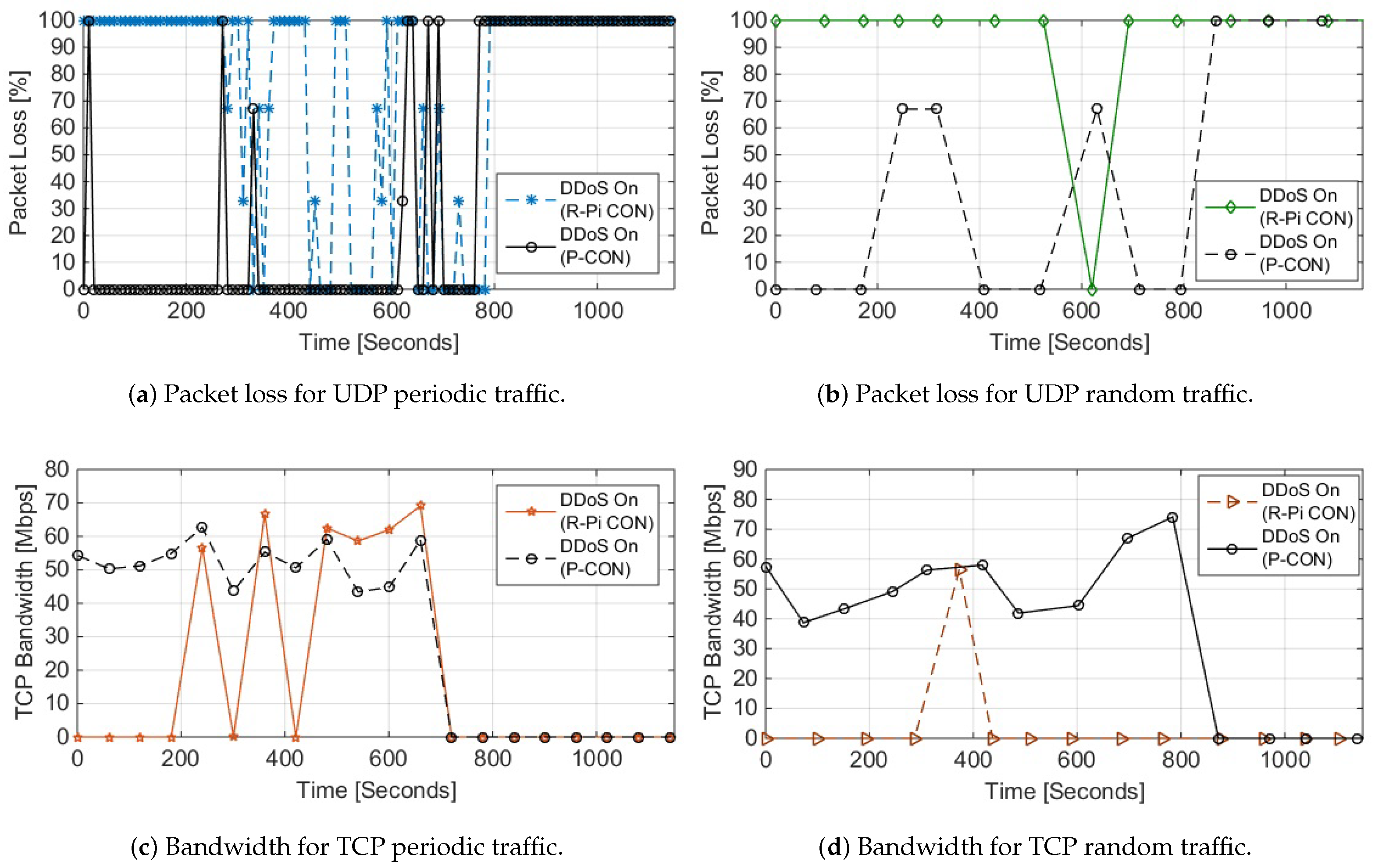
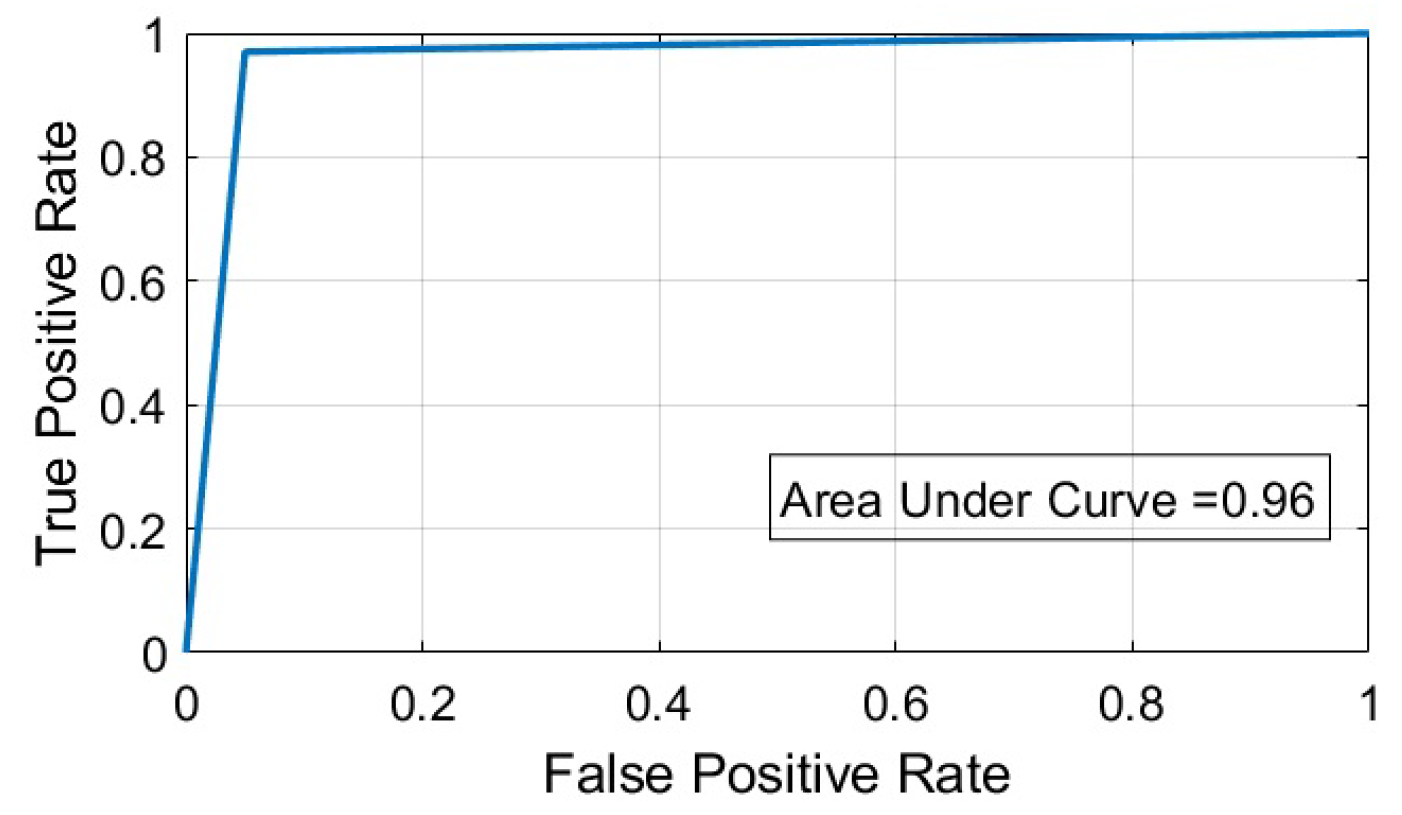
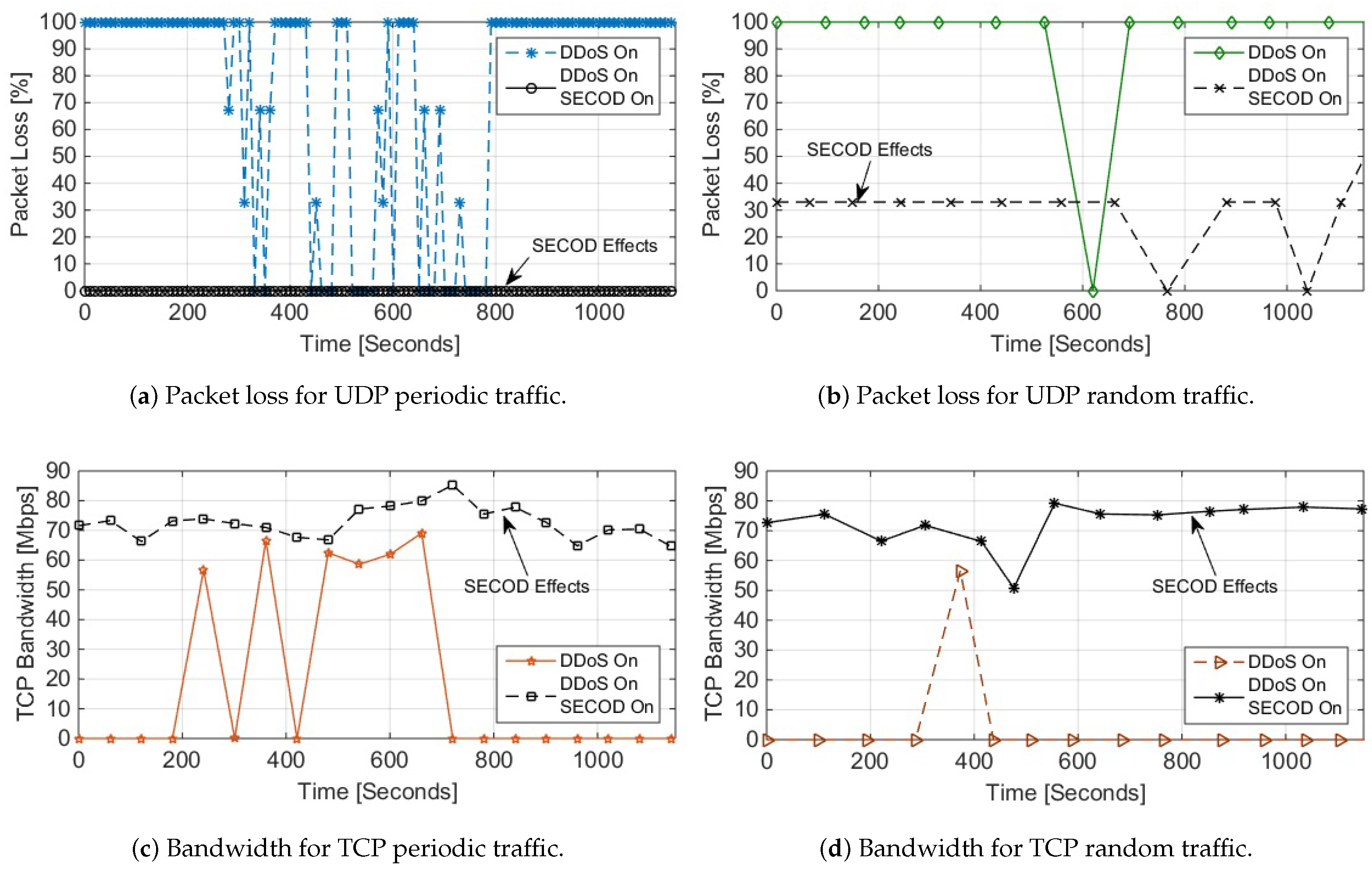
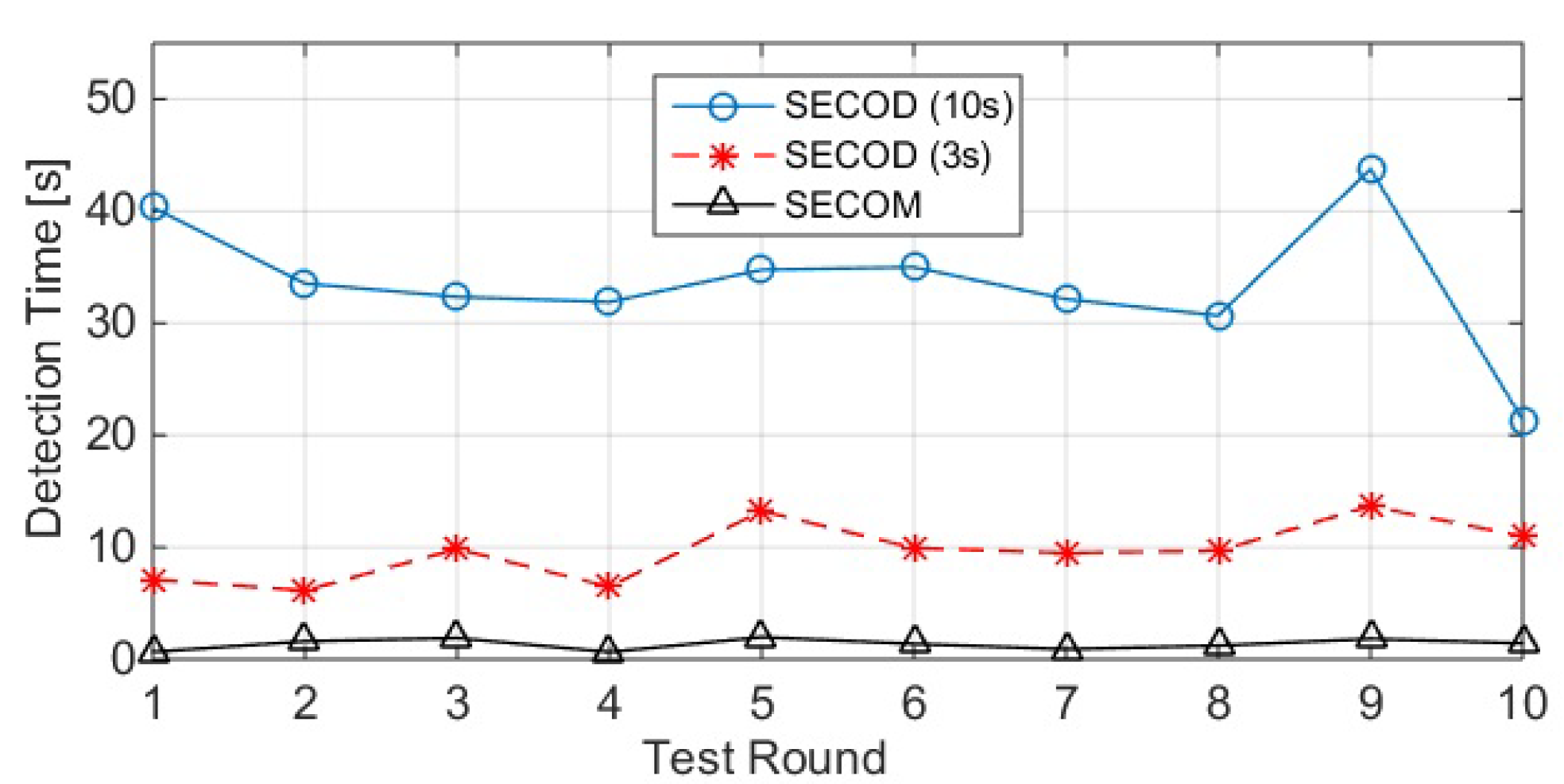
| Algorithm | Simulation | Real Implementation | Detection or Defence | Control or Data Plane | Advantages | Disadvantages |
|---|---|---|---|---|---|---|
| Dao et al. [12] | ✓ | ✗ | Both | Both | Feasible and accurate in the small network. | Resource consumption is high when confronting mature attacks. |
| Mousavi et al. [13] | ✓ | ✗ | Detection | Both | Low resource consumption and short detection time. | Hard to define the threshold of detection for different applications. |
| Dong et al. [14] | ✗ | ✗ | Detection | Control Plane | Prompt and accurate, improvement in false positive and false negative issues. | No simulation or implementation related to SDN. |
| Yan et al. [15] | ✓ | ✗ | Both | Data Plane | Low false positive. | High latency, especially for the users sharing the same port with the attacker. |
| Dharma et al. [16] | ✗ | ✗ | Both | Control Plane | Further inspection to decrease false positive. | Produce delay to legitimate users. |
| Shoeb et al. [17] | ✗ | ✗ | Both | Both | Able to protect the flow table on the switch. | Hard to define key parameters, such as peak time. |
| Xiao et al. [18] | ✓ | ✗ | Detection | Data Plane | High detection rate and low false positive. | Hard to define key parameters, such as abnormal link utilisation. Limited to link flooding attacks. |
| Kokila et al. [19], Phan et al. [20] | ✓ | ✗ | Detection | Control Plane | High accuracy and low false positive. | Performance is based on the training dataset. |
| Lim et al. [21] | ✓ | ✗ | Both | Data Plane | Capable of localising attackers and transformable countermeasures. | Hard to define the metric and threshold. |
| Chin et al. [22] | ✓ | ✗ | Detection | Data Plane | Effective and scalable. | Require extra device and interface. |
| Macedo et al. [23] | ✓ | ✗ | Both | Control Plane | Associate multiple controllers instead of extra devices to mitigate DDoS attacks. | High-frequency attack may result in continual leader controller election. |
| Hameed et al. [24] | ✓ | ✗ | Both | Data Plane | Allows inter-domain defence of DDoS attacks. | Attack with spoofed IP address will make controllers block normal users. |
| Sahay et al. [25] | ✓ | ✓ | Defence | Data Plane | The collaboration between the controller on the customer side and ISP side enables quick response to DDoS attacks. | The link between ISP controller and customer controller becomes a new threat in this model. |
| Algorithm | Simulation | Real Implementation | Detection or Defence | Control or Data Plane | Advantages | Disadvantages |
|---|---|---|---|---|---|---|
| Tortonesi et al. [26] | ✓ | ✗ | Defence | Data Plane | Capable of edge defence due to the programmable controller in the data plane, the work load on the control plane is shared by the data plane. | The interface between SPF controller and programmable controller needs to be defined. The gateway devices shall support both SDN and programmable controller. |
| Özçelik et al. [27] | ✓ | ✗ | Both | Data Plane | Fog computing enables the mitigation of DDoS attacks at the ingress of the network. | Defence mainly focuses on Mirai botnet and TCP protocol, other attack types might need validation. |
| Sarwar et al. [28] | ✓ | ✗ | Both | Control Plane | Existing trustful users can still interact with the controller during DDoS attacks. | The controller rejects all the new flows under DDoS attacks. A legitimate user without a high trust value will encounter more delays when the network is busy. |
| Ravi et al. [29] | ✓ | ✓ | Both | Both | The real-time training keeps the flow rules that are generated by machine learning up-to-date. | The performance of LEDEM relies on the training dataset. The link between local and universal controllers needs to be defined. |
| Sharma et al. [30] | ✓ | ✗ | Detection | Both | The proposed mechanism is able to detect not only DDoS attacks but also other types of attacks. | New-flow attacks against one network slice might saturate system resources, as it triggers a new flow record and the update in the detection pattern. |
| Nobakht et al. [31] | ✗ | ✓ | Both | Data Plane | Detection is based on the IoT application, which means the behaviour in the network is predictable for a specific application. | The performance of detection might highly rely on the habit of using the application. For a flexible application, it could result to a low accuracy in the detection. |
| IoT Application | Periodical Message | Event Trigger |
|---|---|---|
| Smart Home | ✗ | ✓ |
| Wearables | ✗ | ✓ |
| Connected Car | ✗ | ✓ |
| Industrial IoT | ✗ | ✓ |
| Smart City | ✓ | ✓ |
| Agriculture | ✓ | ✓ |
| Smart Retail | ✗ | ✓ |
| Smart Grid | ✓ | ✓ |
| Healthcare | ✓ | ✓ |
| Farming | ✓ | ✓ |
| Symbol | Definition |
|---|---|
| i | Port ID on a switch, where i = 1, 2… n |
| j | Switch ID in the network, where j = 1, 2…m |
| k | IP address ID under a specific switch port, if an IP address is the first IP who generates a request towards the controller under a switch port, then k = 1 for this IP address under switch m port n. |
| Count of messages, where indicates the IP address from port in switch. | |
| The maximum number of messages that is allowed from one switch within a time period. It is the switch threshold. As the target of DDoS attack is to exhaust resources, is defined based on the maximum system resources that users would like to assign to the switch for new flow processing, i.e., a switch can generate up to 1000 messages per minute, the administrator can set to 500 per minute, which means the switch is allowed to use up to 50% of its resources to generate messages. This value varies according to the application and customer requirement. is defined before a switch joins the network, and this threshold will not change over time. | |
| The maximum number of messages that is allowed from one switch port within a time period. It is the port threshold. The initial port threshold is , it is defined by and the number of ports under a switch, i.e., a switch has 5 ports and is 500 per minute, then is 100 per minute. will update according to the network behaviour. | |
| The maximum number of messages that is allowed from one IP address under a specific switch port within a time period. It is the IP threshold. is also dependent on the performance of the switch, because a more powerful switch could allow a user to make more requests. This threshold is predefined by the administrator and will not change over time. |
Publisher’s Note: MDPI stays neutral with regard to jurisdictional claims in published maps and institutional affiliations. |
© 2021 by the authors. Licensee MDPI, Basel, Switzerland. This article is an open access article distributed under the terms and conditions of the Creative Commons Attribution (CC BY) license (http://creativecommons.org/licenses/by/4.0/).
Share and Cite
Wang, S.; Gomez, K.; Sithamparanathan, K.; Asghar, M.R.; Russello, G.; Zanna, P. Mitigating DDoS Attacks in SDN-Based IoT Networks Leveraging Secure Control and Data Plane Algorithm. Appl. Sci. 2021, 11, 929. https://doi.org/10.3390/app11030929
Wang S, Gomez K, Sithamparanathan K, Asghar MR, Russello G, Zanna P. Mitigating DDoS Attacks in SDN-Based IoT Networks Leveraging Secure Control and Data Plane Algorithm. Applied Sciences. 2021; 11(3):929. https://doi.org/10.3390/app11030929
Chicago/Turabian StyleWang, Song, Karina Gomez, Kandeepan Sithamparanathan, Muhammad Rizwan Asghar, Giovanni Russello, and Paul Zanna. 2021. "Mitigating DDoS Attacks in SDN-Based IoT Networks Leveraging Secure Control and Data Plane Algorithm" Applied Sciences 11, no. 3: 929. https://doi.org/10.3390/app11030929
APA StyleWang, S., Gomez, K., Sithamparanathan, K., Asghar, M. R., Russello, G., & Zanna, P. (2021). Mitigating DDoS Attacks in SDN-Based IoT Networks Leveraging Secure Control and Data Plane Algorithm. Applied Sciences, 11(3), 929. https://doi.org/10.3390/app11030929







